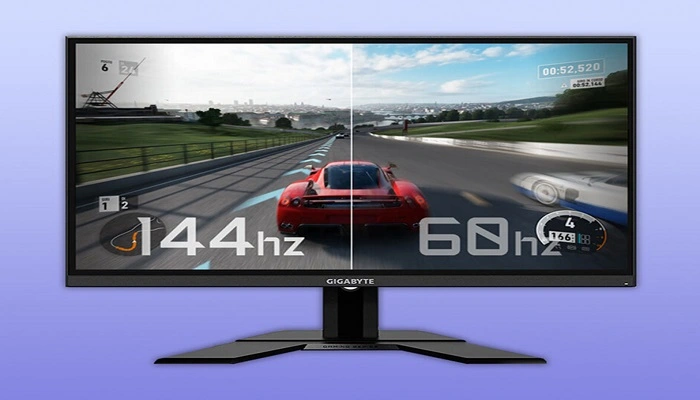The fast refresh rate describes how often a screen refreshes its picture. The display’s refresh rate is expressed in hertz, whereas the duration between refreshes is measured in milliseconds (ms) (Hz). Your screen’s refresh rate is the number of times per second at which a brand-new picture may be drawn. Hertz is the unit of measurement for frequency (Hz). If your screen refreshes the picture 144 times per second, it is doing so at that pace. Smoother gameplay and perhaps greater frame rates are possible when combined with the high frame rates provided by a GPU and CPU working together.
Let’s take a look at 7 benefits of using fast refresh rate monitors.
1.Motion Clarity
One of the best features of 144hz monitors is improved motion clarity. The clarity of a moving picture is dependent on its motion resolution. When dealing with fast-moving images, this is essential. Any activity involving a high level of tension and action, such as a real-time strategy game, would qualify. A higher monitor resolution will improve the user’s ability to distinguish between on-screen elements, allowing for sharper visuals and more proficient gameplay.
2.Display Type:
Generally, home office monitors come with one of the three kinds of display technologies mentioned below:
LCD(Liquid Crystal Display):
Monitors that come with in-built LCD technology are affordable and offer the best viewing angles. On these monitors, images are basically produced with the help of light. LCD monitors have in-built colorizing liquid crystal panels that simplify graphic-intensive images.
LED(Light -Diode):
Typically, monitors with LED type displays use small, bright LEDs as a source of light. These models are thinner compared to traditional LCDs.
IPS(In-Plane Switching):
IPS displays are basically LED-backlit but they use a new panel technology that leads to a faster response time, wider viewing angles, and more facilities.
3.Variable Refresh Rate
Most high-end gaming displays use variable refresh rates technologies like G-Sync or FreeSync to provide smooth, uninterrupted gameplay. They do this by cooperating with the display’s predetermined refresh rate. VRR kicks in whenever frames aren’t going to show, matching the refresh rate to the game’s framerate to prevent any tearing that might otherwise appear on the screen.
4. Decrease in Screen Tearing
When more frames per second are generated than the screen can display, tearing occurs. A game running at 144 frames per second will look choppy on a 60Hz display because it generates far more frames per second than the screen can display. V-Sync (Vertical Synchronisation) is a common workaround for this problem that works by reducing the number of frames-per-second your graphics card can render. It’s important to remember that V-sync has some drawbacks, such as increased input lag and decreased responsiveness.
5. Less Lag
In first-person shooters, where the screen is constantly moving, input latency may be a game-changer. The input latency of a monitor is proportional to its refresh rate. For instance, owing to technical constraints, a standard 60Hz display can never have an input latency of less than 16ms. How quickly the on-screen pixels transition from black to white or gray is determined by the display’s reaction time. Ghosting, or blurriness in fast-moving pictures, is proportional to reaction time. When reaction time and motion resolution are both high, ghosting is reduced.
In resource-intensive tasks like gaming, video editing, graphic designing and so on, minimum lag is ideal for completing these activities smoothly.
6. Easier Web Browsing
A monitor or display panel with a refresh rate of 90Hz or 120Hz is superior to one with a 60Hz refresh rate from a user’s perspective. The user experience is fluid and responsive, making it a pleasure to scroll across the web or social networking applications. As an added bonus, a high refresh rate gives the impression that the gadget is quick and fluid.
With quick browsing you can perform frequent searches of multiple topics. This is especially beneficial for students and new age learners.
7. Easier on the Eyes
The strain on your eyes may be reduced by using a screen with a high refresh rate. Flickering and stuttering become more visible around 60Hz, making it difficult on the eyes for people used to displays with speeds of at least 90 Hz to 120Hz.
Moreover, some monitors come with eye-care certification. This certification guarantees low blue-light emission which is good for eyes. It automatically measures the shape of the human eye. Due to the curvature of the screen,the distance between your eyes and the screen remains the same.
Conclusion
With a refresh rate of 144 hertz, a monitor more than doubles the rate of standard 60-hertz displays and reduces input latency by more than half. All things considered, 144Hz monitors have established themselves as the gold standard. Because of the dramatic enhancements they bring to the gaming experience and the value they provide, they should be on every gamer’s wish list. They improve the browsing and video-watching experience for everyone, not just gamers.







